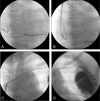ICD Leads Extraction and Clearing of Access Way in a Patient With Superior Vena Cava Syndrome: Building A Tunnel
- PMID: 26402803
- PMCID: PMC4635743
- DOI: 10.1097/MD.0000000000001481
ICD Leads Extraction and Clearing of Access Way in a Patient With Superior Vena Cava Syndrome: Building A Tunnel
Abstract
Central vein disease is defined as at least 50% narrowing up to total occlusion of central veins of the thorax including superior vena cava, brachiocephalic, subclavian, and internal jugular vein. Thrombosis due to intravascular leads occurs in approximately 30% to 45% of patients early or late after implantation of a pacemaker by transvenous access.In this case, we report a male patient, 65-years old, hypertensive, type 2 diabetic, with atherosclerotic disease, coronary artery disease, underwent coronary artery bypass surgery in the past 10 years, having already experienced an acute myocardial infarction, bearer automatic implantable cardioverter defibrillator for 8 years after an episode of aborted sudden death due to ischemic cardiomyopathy, presenting left superior vena cava syndrome. The use of clopidogrel and rivaroxaban for over a year had no benefit on symptoms improvement.After atrial and ventricular leads extraction, a new shock lead was positioned in the right ventricle using active fixation and a new atrial lead was positioned in the right atrium, passing inside of the stents. Two days after the procedure the patient was asymptomatic and was discharged.
Conflict of interest statement
The authors have no funding and conflicts of interest to disclose.
Figures




Similar articles
-
Managing superior vena cava syndrome in patients with cardiac implantable electronic device leads: Strategies and considerations.Heart Rhythm. 2025 Feb;22(2):311-317. doi: 10.1016/j.hrthm.2024.06.060. Epub 2024 Jul 3. Heart Rhythm. 2025. PMID: 38969051
-
Surgical lead extraction for total occlusion of the superior vena cava by chronic lead infection after mustard procedure.J Card Surg. 2014 May;29(3):406-9. doi: 10.1111/jocs.12290. Epub 2014 Jan 18. J Card Surg. 2014. PMID: 24438576
-
Superior vena cava thrombosis and paradoxical embolic stroke due to collateral drainage from the brachiocephalic vein to the left atrium.Tex Heart Inst J. 2011;38(2):170-3. Tex Heart Inst J. 2011. PMID: 21494530 Free PMC article.
-
Venous thrombosis and stenosis after implantation of pacemakers and defibrillators.J Interv Card Electrophysiol. 2005 Jun;13(1):9-19. doi: 10.1007/s10840-005-1140-1. J Interv Card Electrophysiol. 2005. PMID: 15976973 Review.
-
Successful management of multiple permanent pacemaker complications--infection, 13 year old silent lead perforation and exteriorisation following failed percutaneous extraction, superior vena cava obstruction, tricuspid valve endocarditis, pulmonary embolism and prosthetic tricuspid valve thrombosis.J Cardiothorac Surg. 2009 Feb 24;4:12. doi: 10.1186/1749-8090-4-12. J Cardiothorac Surg. 2009. PMID: 19239701 Free PMC article. Review.
Cited by
-
The Use of Transvenous Lead Extraction of Non-Infected Leads to Prevent Long-Term Lead-Related Complications.Sovrem Tekhnologii Med. 2021;13(1):66-69. doi: 10.17691/stm2021.13.1.08. Epub 2021 Feb 28. Sovrem Tekhnologii Med. 2021. PMID: 34513068 Free PMC article.
-
3 Cases of Superior Vena Cava Syndrome Following Percutaneous Right Ventricular Assist Device Placement.JACC Case Rep. 2021 Nov 3;3(15):1690-1693. doi: 10.1016/j.jaccas.2021.09.005. eCollection 2021 Nov 3. JACC Case Rep. 2021. PMID: 34766020 Free PMC article.
References
-
- Modabber M, Kundu S. Central venous disease in hemodialysis patients: an update. Cardiovasc Intervent Radiol 2013; 36:898–903. - PubMed
-
- Wilson LD, Detterbeck FC, Yahalom J. Superior vena cava syndrome with malignant causes. N Engl J Med 2007; 356:1862–1869. - PubMed
-
- Rice TW, Rodriguez RM, Light RW. The superior vena cava syndrome: clinical characteristics and evolving etiology. Medicine 2006; 85:37–42. - PubMed
-
- Spittell PC, Hayes DL. Venous complications after insertion of atransvenous pacemaker. Mayo Clin Proc 1992; 67:258–265. - PubMed
-
- Mazzetti H, Dussaut A, Tentori C, et al. Superiorvena cava occlusion and/or syndrome related to pacemaker leads. Am Heart J 1993; 125:831–837. - PubMed
Publication types
MeSH terms
LinkOut - more resources
Full Text Sources
Medical
Miscellaneous

